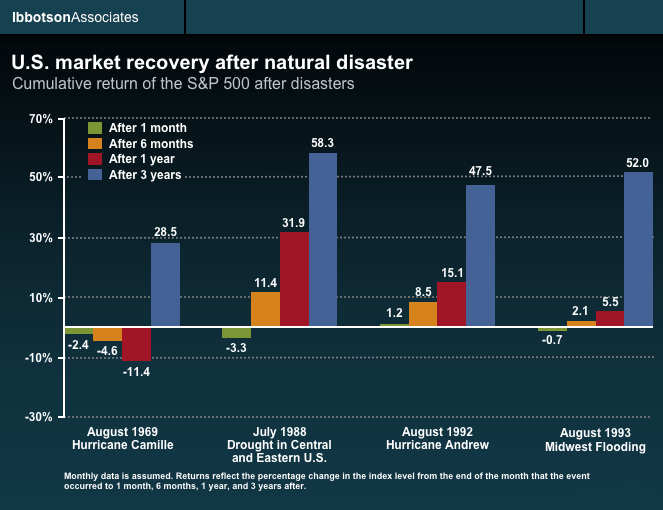 U.S. market recovery after natural disaster
After the country has been hit with a natural disaster, U.S. stock prices may initially drop, but they often gradually improve in subsequent months and years. This image illustrates the cumulative return of stocks following four natural disasters in American history. In the short term, uncertainty from such external shocks may create sudden drops in value. For example, stocks had negative returns one month after the 1988 drought and 1993 flooding. Over a longer period of time such as 6 months, 1 year, and 3 years, however, returns were positive. The United States has survived nature's fury ranging from Hurricane Camille in 1969 to the Midwest Flooding in 1993. Hurricane Camille was a Category 5 hurricane that cost billions in economic damages and caused loss of life in the hundreds. The drought/heat wave in the summer of 1988 that blanketed the Eastern and Central U.S. caused an estimated $40 billion in damages to the agricultural and related industries, and over 5,000 deaths. Hurricane Andrew, a Category 4 hurricane, hit Florida in 1992 destroying over 125,000 homes leading to $27 billion in damages. One year after Andrew, the Midwest suffered massive flooding due to heavy rains and thunderstorms causing $21 billion in damages. Hurricane Katrina, a Category 4 hurricane that hit in August of 2005, may be the costliest natural disaster yet. Katrina damaged oil production capabilities for the Gulf Coast region, sending oil and gas prices dramatically higher. The entire city of New Orleans had to be evacuated, with a majority of structures suffering severe water damage from flooding. The loss of life could well be in the thousands for this terrible event. Natural disasters are particularly difficult for people to deal with because of their unpredictability. Fear and uncertainty may lead investors to sell their investments, putting downward pressure on prices. Trading on such emotions can be detrimental to a portfolio's value. By selling during a dip in the market, investors may realize short-term losses. Then, as they wait and hesitate to get back into the market, they may miss parts of the potential recovery. Calculations assume monthly data. The month the event occurred is excluded from the return calculations. Returns and principal invested in stocks are not guaranteed. The data assumes reinvestment of all income and does not account for taxes or transaction costs. Source: Stocks--Standard & Poor's 500®, which is an unmanaged group of securities and considered to be representative of the stock market in general; Natural disaster background information--National Oceanic and Atmospheric Administration, U.S. Department of Commerce. | 







